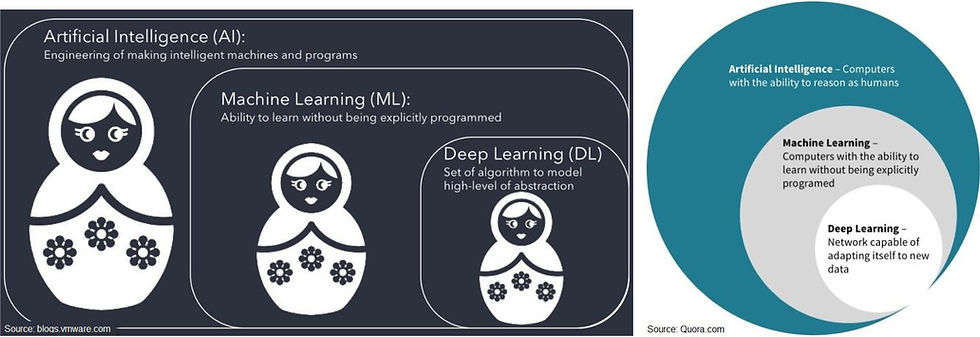All Machine Learning is AI but not all AI is Machine Learning
- Jitin Cherian
- May 27, 2021
- 3 min read
Updated: May 30, 2021
Artificial intelligence (AI), Machine Learning and deep learning are three terms often used interchangeably to describe software that behaves intelligently. However, it is useful to understand the key distinctions among them.
You can think of deep learning, machine learning and artificial intelligence as a set of Russian dolls nested within each other, beginning with the smallest and working out.

Deep learning is a subset of machine learning, and machine learning is a subset of AI, which is an umbrella term for any computer program that does something smart.
In other words, all machine learning is AI, but not all AI is machine learning, and so forth.
AI
can be a pile of if-then statements, or a complex statistical model mapping raw sensory data to symbolic categories. The if-then statements are simply rules explicitly programmed by a human hand. Taken together, these if-then statements are sometimes called rules engines, expert systems, knowledge graphs or symbolic AI. Collectively, these are known as Good, Old-Fashioned AI (GOFAI).
Machine learning
is a subset of AI. That is, all machine learning counts as AI, but not all AI counts as machine learning. For example, symbolic logic – rules engines, expert systems and knowledge graphs – could all be described as AI, and none of them are machine learning. One aspect that separates machine learning from the knowledge graphs and expert systems is its ability to modify itself when exposed to more data; i.e. machine learning is dynamic and does not require human intervention to make certain changes. That makes it less brittle, and less reliant on human experts. The “learning” part of machine learning means that ML algorithms attempt to optimize along a certain dimension; i.e. they usually try to minimize error or maximize the likelihood of their predictions being true. This has three names: an error function, a loss function, or an objective function, because the algorithm has an objective… When someone says they are working with a machine-learning algorithm, you can get to the gist of its value by asking: What’s the objective function? Machine Learning in short is an optimization algorithm. If you tune them right, they minimize their error by guessing and guessing and guessing again.
Deep learning
is a subset of machine learning. Usually, when people use the term deep learning, they are referring to deep artificial neural networks. Deep artificial neural networks are a set of algorithms that have set new records in accuracy for many important problems, such as image recognition, sound recognition, recommender systems, natural language processing etc. It is a field of study that gives computers the ability to learn without being explicitly programmed and it tends to result in higher accuracy, require more hardware or training time, and perform exceptionally well on machine perception tasks that involved unstructured data such as blobs of pixels or text.
Next in AI?
There are three main schools of thought on how people talk about AI.
Those who believe that AI progress will continue tend to think a lot about strong AI, and whether or not it is good for humanity. Among those who forecast continued progress, one group emphasizes the benefits of more intelligent software, which may save humanity from its current stupidities; the other group worries about the existential risk of a superintelligence.
Those who do not believe that AI is making that much progress relative to human intelligence are forecasting another AI winter, during which funding will dry up due to generally disappointing results, as has happened in the past. Many of those people have a pet algorithm or approach that competes with deep learning.
Finally, there are the pragmatists, plugging along at the math, struggling with messy data, scarce AI talent and user acceptance. They are the least religious of the groups making prophesies about AI – they just know that it’s hard.
Given that the power of AI progresses hand in hand with the power of computational hardware, advances in computational capacity, such as better chips or quantum computing, will set the stage for advances in AI. Speaking about Quantum Computing -
Machine-learning and quantum computing are two technologies that have incredible potential in their own right. Now researchers are bringing them together. The main goal is to achieve a so-called quantum advantage, where complex algorithms can be calculated significantly faster than with the best classical computer. This would be a game-changer in the field of AI.
What school of thought on AI do you agree with? Would you like me to elaborate in a separate article on what happens when Quantum Computing and AI collide?
Let me know in the comments section below. Thank you for reading. Cheers!






Comments